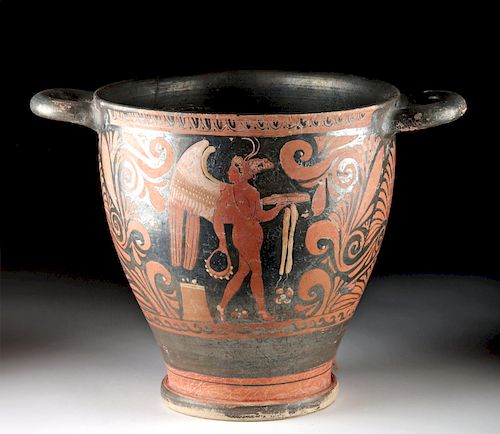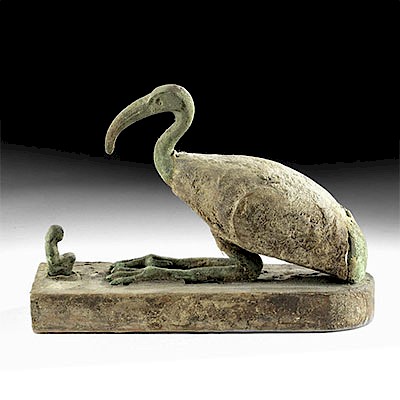Huge Greek Apulian Red-Figure Skyphos
Lot 36
About Seller
Artemis Fine Arts
686 S Taylor Ave, Ste 106
Louisville, CO 80027
United States
Selling antiquities, ancient and ethnographic art online since 1993, Artemis Gallery specializes in Classical Antiquities (Egyptian, Greek, Roman, Near Eastern), Asian, Pre-Columbian, African / Tribal / Oceanographic art. Our extensive inventory includes pottery, stone, metal, wood, glass and textil...Read more
Estimate:
$12,000 - $15,000
Absentee vs Live bid
Two ways to bid:
- Leave a max absentee bid and the platform will bid on your behalf up to your maximum bid during the live auction.
- Bid live during the auction and your bids will be submitted real-time to the auctioneer.
Bid Increments
| Price | Bid Increment |
|---|---|
| $0 | $25 |
| $300 | $50 |
| $1,000 | $100 |
| $2,000 | $250 |
| $5,000 | $500 |
| $10,000 | $1,000 |
| $20,000 | $2,500 |
| $50,000 | $5,000 |
| $100,000 | $10,000 |
| $200,000 | $20,000 |
About Auction
By Artemis Fine Arts
Oct 31, 2019
Set Reminder
2019-10-31 10:00:00
2019-10-31 10:00:00
America/New_York
Bidsquare
Bidsquare : Fine Antiquities, Asian, Ethnographic Art
https://www.bidsquare.com/auctions/artemis-gallery/fine-antiquities-asian-ethnographic-art-4581
Our Halloween Day auction features classical antiquities, ancient and ethnographic art from cultures encompassing the globe, plus fine art. Artemis Fine Arts info@artemisgallery.com
Our Halloween Day auction features classical antiquities, ancient and ethnographic art from cultures encompassing the globe, plus fine art. Artemis Fine Arts info@artemisgallery.com
- Lot Description
Magna Graecia, Apulian, ca. 4th century BCE. A massive red figure skyphos of a classic form presenting an impressive iconographic program. Side A features a winged Eros walking in a graceful manner with his right leg progressing before his left leg, chest facing forward, and visage gazing behind. His wings are elaborately delineated with fugitive yellow and pink pigment, and an altar is presented below the wingtips. The god of love holds a patera adorned with filets in his left hand and a wreath or tambourine in his right hand. Side B features a feminine maiden dressed in a lovely chiton with drapery folds cascading over her figure. Her curly coiffure is raised and dressed with a ribboned stephane. She gazes at the mirror in her right hand and holds a tambourine or wreath in her left hand just above an altar. In addition to this iconography, the decorative program is very well done - featuring bands of egg and dart above and repeating wave motifs below. Size: 16.125" W handlespan x 11.75" H (41 cm x 29.8 cm)
What's more, impressive double palmettes adorn the areas beneath the handles. On the underside is a bold makers mark comprised of a red "X" superimposed over two concentric circles.
Perhaps the most exciting innovation in Greek vase painting was the red-figure technique, invented in Athens around 525 BCE and beloved by other artists of Magna Graecia. The red-figure technique allowed for much greater flexibility as opposed to the black-figure technique, for now the artist could use a soft, pliable brush rather than a rigid metal graver to delineate interior details, play with the thickness of the lines, as well as build up or dilute glazes to create chromatic effects. The painter would create figures by outlining them in the natural red of the vase, and then enrich these figural forms with black lines to suggest volume, at times perspectival depth, and movement, bringing those silhouettes and their environs to life. Beyond this, fugitive pigments made it possible for the artist to create additional layers of interest and detail as we see in this example.
Provenance: private Owen collection, Sussex County, New Jersey, USA, acquired in the 1990s from a US-based dealer
All items legal to buy/sell under U.S. Statute covering cultural patrimony Code 2600, CHAPTER 14, and are guaranteed to be as described or your money back.
A Certificate of Authenticity will accompany all winning bids.
We ship worldwide and handle all shipping in-house for your convenience.
#146029Professionally repaired from multiple pieces with slight repainted areas over the break lines. Expected surface wear with scuffs and minor pigment loss as shown; however, imagery is still quite legible. Black glaze has developed a lovely silvery iridescence.Condition
- Shipping Info
-
All shipping is handled in-house for your convenience. Your invoice from Artemis Gallery will include shipping calculation instructions. If in doubt, please inquire BEFORE bidding for estimated shipping costs for individual items.
-
- Buyer's Premium



 EUR
EUR CAD
CAD AUD
AUD GBP
GBP MXN
MXN HKD
HKD CNY
CNY MYR
MYR SEK
SEK SGD
SGD CHF
CHF THB
THB
















